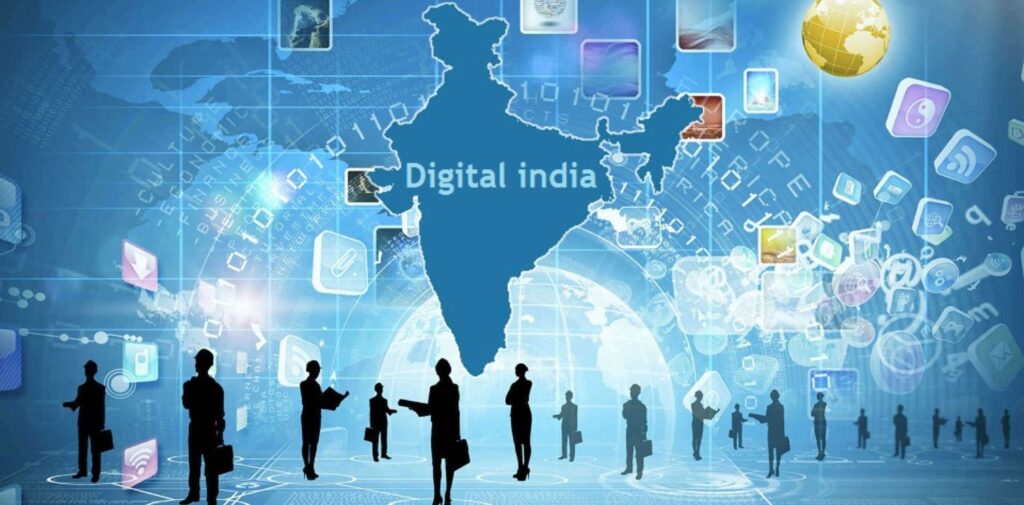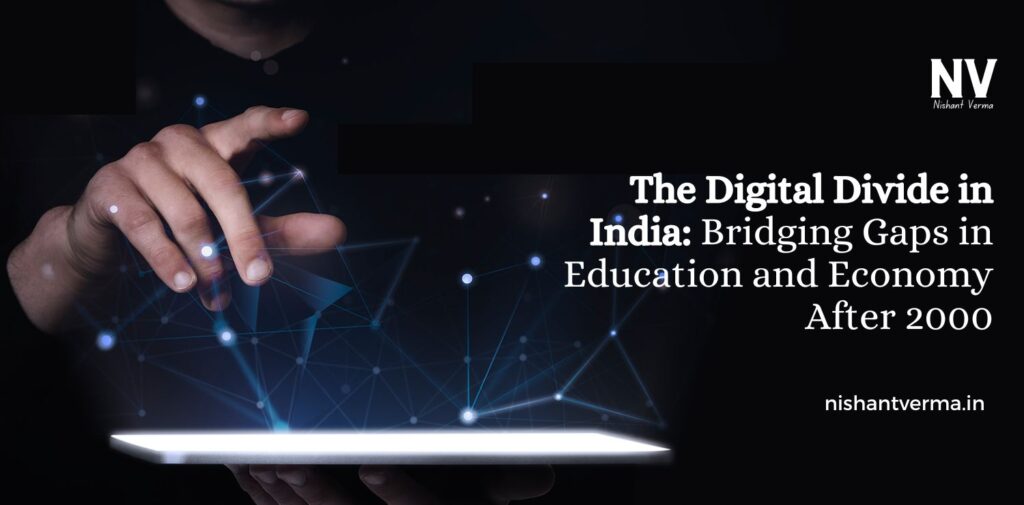India is a nation that has made significant strides in technology and innovation since the turn of the 21st century. From the rise of the IT industry to the widespread use of smartphones, the country has transformed into a global hub for technology. However, despite this progress, a major challenge continues to hinder India’s growth: the digital divide.
The digital divide refers to the gap between those who have access to modern technology and those who do not. In India, this divide has been particularly pronounced in terms of education and the economy, with millions of people still unable to benefit from the digital revolution. This article explores how the Digital Divide in India has impacted since 2000 and the ongoing efforts to bridge these gaps in both education and the economy.
Digital Divide: What Is It?
The digital divide is essentially the difference between individuals, communities, and regions that have access to digital technologies and those that do not. These technologies include computers, the internet, mobile phones, and other digital tools. The divide can be seen in terms of:
- Infrastructure: Some areas, especially rural and remote regions, lack the necessary infrastructure like high-speed internet or electricity to fully participate in the digital world.
- Skills and Literacy: Even if people have access to devices, a lack of digital literacy prevents them from making effective use of technology.
- Economic Disparity: People in lower-income households often cannot afford smartphones, computers, or internet subscriptions, making it difficult for them to leverage digital opportunities.
As India rapidly moves toward a digital economy, addressing the digital divide has become crucial for ensuring that all citizens can participate in the nation’s progress.

The Impact of the Digital Divide on Education
One of the most significant consequences of the digital divide in India is its impact on education. In recent years, digital tools have become essential for learning, and this has widened the gap between students in urban and rural areas.
1. Limited Access to Online Learning Resources
In the 21st century, technology has transformed education by providing access to online resources, e-learning platforms, and virtual classrooms. During the COVID-19 pandemic, for example, online education became the primary mode of teaching. However, many students in rural areas or from low-income families face difficulty accessing these resources due to a lack of internet access or digital devices. Schools in urban areas, on the other hand, were better equipped to adapt to online learning, leading to significant disparities in education quality.
2. Digital Literacy and Skill Development
Even when students have access to devices, digital literacy remains a significant issue. Many children, especially in rural areas, are not taught how to use computers or navigate the internet. As a result, they are left behind when it comes to acquiring critical skills that are needed in today’s digital economy. Schools in urban centres, on the other hand, often have more resources and trained teachers who can impart digital skills.
3. Lack of Infrastructure in Rural Schools
Rural schools often lack the infrastructure required to integrate technology into the classroom. While urban schools may have computer labs, projectors, and Wi-Fi, rural schools struggle with basic facilities like electricity and functional classrooms. This creates a barrier for students in these areas, limiting their exposure to digital learning tools.

The Economic Impact of the Digital Divide
The digital divide does not just impact education—it also affects people’s ability to access economic opportunities. As India’s economy grows and becomes more digitized, those who cannot keep up with the digital world are at a severe disadvantage.
1. Employment Opportunities
Many job sectors in India, especially in IT, customer service, and finance, now require digital skills. Those who cannot access the internet or learn digital tools find themselves locked out of these opportunities. On the other hand, those in urban centres or with the necessary skills can access higher-paying jobs in tech-related fields. This further deepens the divide between urban and rural areas, as well as between the rich and the poor.
2. E-commerce and Digital Payment Systems
The rise of e-commerce and digital payment systems has revolutionized the way business is done in India. However, for people without access to the internet or smartphones, these platforms remain out of reach. While large cities like Mumbai, Delhi, and Bengaluru are thriving in the e-commerce space, rural regions often rely on traditional methods of commerce, further limiting their access to the economic benefits of digitalization.
3. Government Services and Digital Inclusion
The Indian government has pushed for the digitization of services, from banking to health care. While initiatives like the Digital India program aim to provide electronic government services, people in rural areas often struggle to access these services due to a lack of internet connectivity. This limits their ability to benefit from government schemes like Direct Benefit Transfer (DBT), e-governance services, and online healthcare consultations, thereby widening the economic gap.
Bridging the Gap in Education
Several initiatives have been launched over the past decade to bridge the digital divide in India’s education sector. These efforts aim to provide access to technology, improve digital literacy, and ensure that no child is left behind.
1. Digital India Campaign
The Digital India initiative, launched in 2015, aims to transform India into a digitally empowered society. This includes the expansion of internet connectivity, especially in rural areas, as well as providing affordable digital devices to students. As part of this campaign, the government has worked to improve the digital infrastructure in schools and provide e-learning resources to teachers and students.
2. Government Programs for Digital Education
Programs like the National Mission on Education through Information and Communication Technology (NMEICT) and SWAYAM (Study Webs of Active Learning for Young Aspiring Minds) aim to make quality education accessible to all students, particularly those in remote areas. These platforms offer online courses, digital content, and other educational resources that can be accessed by students for free or at low cost.
3. Private Sector Contributions
In addition to government efforts, private companies and NGOs are also playing a role in bridging the digital divide in education. Companies like Tata Consultancy Services (TCS) and Microsoft have partnered with educational institutions to provide digital literacy training, online courses, and affordable devices to students. NGOs are also working to provide computer literacy training to students in underserved areas, enabling them to gain digital skills that are essential for their future careers.

Economic Initiatives to Address the Digital Divide
In the economic sphere, bridging the digital divide is just as important as in education. The government and private companies have taken steps to ensure that more people have access to digital tools, creating a more inclusive economy.
1. Expansion of Internet Connectivity
The government has launched initiatives like BharatNet to expand internet connectivity to rural areas. The aim is to provide high-speed internet access to over 250,000 villages, thus ensuring that even the most remote areas can access online services, education, and economic opportunities.
2. Affordable Smartphones and Devices
As smartphones become the primary means of accessing the internet in India, companies have introduced affordable smartphones aimed at low-income families. These efforts are crucial in ensuring that people in rural areas and from disadvantaged communities can access online services, e-commerce platforms, and government schemes.
3. Digital Financial Inclusion
In recent years, India has made significant strides in promoting digital financial inclusion. Programs like Jan Dhan Yojana have opened millions of bank accounts for people in rural and underserved areas, while initiatives like UPI (Unified Payments Interface) have made digital transactions simple and accessible. These efforts are crucial in ensuring that everyone, regardless of their background, can participate in India’s digital economy.
Conclusion: The Digital Divide in India:
The digital divide remains one of India’s most pressing challenges in the 21st century. Despite significant progress, millions of people continue to be excluded from the benefits of digital technology due to factors like lack of infrastructure, digital literacy, and economic inequality. However, the Indian government and private sector are actively working to bridge these gaps through initiatives focused on providing access to digital tools, improving digital literacy, and promoting digital financial inclusion.
As India continues to grow and embrace the digital age, efforts to bridge the digital divide must remain a priority. Only then can India ensure that its digital future is inclusive, equitable, and beneficial for all its citizens—regardless of their location or socio-economic background. The challenge is immense, but with concerted efforts, the digital divide can be bridged, allowing all Indians to benefit from the opportunities the digital world has to offer.




